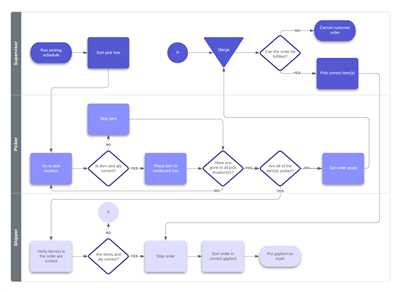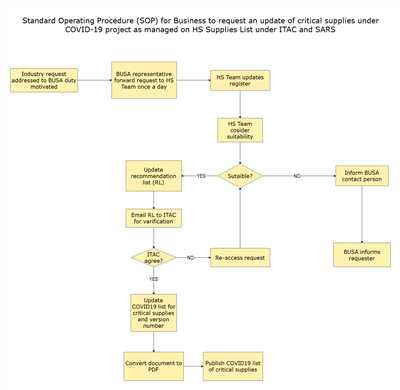
When it comes to creating a Standard Operating Procedure (SOP), having a clear and well-defined flowchart is essential. This type of visual representation allows you to understand and communicate the step-by-step process of a work or operating procedure.
By using flowcharts, you can easily describe the different processes involved in a workflow. This collaborative and visual solution enables you to start with what your SOP is meant to achieve and then map out the necessary steps.
In this article, we will guide you through the process of creating a SOP flowchart. We will provide you with examples and material to help you make your own template. Whether you are describing a case study, procedure, or requisition, using flowcharts is an effective way to illustrate processes in a clear and organized manner.
There are different formats and diagrams you can use to create flowcharts, such as SWOT charts, warehousing diagrams, and process mapping. No matter what type of SOP you are working on, this guide will give you the tools and knowledge to easily create a standard operating procedure flowchart.
What is a Standard Operating Procedure (SOP): Examples and Applications
A Standard Operating Procedure (SOP) is a document that describes in specific detail the step-by-step process of executing a particular task or activity. It serves as a reference guide that ensures consistency and quality in performing routine operations. SOPs are widely used in various industries and organizations to standardize processes, increase efficiency, and maintain compliance with regulations.
Examples of SOPs

There are numerous examples of SOPs that can be created for different processes within an organization. Some common examples include:
- Employee onboarding and offboarding procedures
- Inventory management and control
- Customer service protocols
- Quality control and assurance
- Safety and emergency procedures
- Standardized manufacturing processes
Applications of SOPs
SOPs have a wide range of applications across industries and sectors. Here are some key applications:
1. Describing Processes: SOPs are used to describe and document the steps involved in a specific process. This provides clarity and ensures that everyone involved understands how to carry out the task effectively.
2. Standardizing Procedures: SOPs help standardize procedures, ensuring consistent quality and reducing errors. By following a set procedure, organizations can minimize variations and ensure the desired outcomes.
3. Enhancing Collaboration: SOPs facilitate collaboration by providing a common reference point for employees. They enable teams to work together efficiently, as everyone is aligned with the documented procedures and workflows.
4. Training and Onboarding: SOPs are valuable tools for training new employees. They provide a structured guide for training sessions, making it easier to onboard new team members and bring them up to speed quickly.
5. Compliance and Regulations: Many industries, such as healthcare and finance, have strict compliance requirements. SOPs help ensure compliance by outlining the necessary steps to follow to meet regulatory standards.
6. Process Improvement: SOPs also serve as a starting point for process improvement initiatives. By analyzing existing SOPs, organizations can identify areas for optimization and make necessary adjustments to improve efficiency and effectiveness.
In the case of warehousing, for example, an SOP might include steps for receiving, storing, and distributing material. This ensures that the workflow is well-documented and followed consistently, reducing errors and ensuring smooth operations.
In summary, SOPs are essential documents that provide a standardized solution for describing and executing processes within an organization. They are used in various industries to ensure consistency, efficiency, compliance, and continuous process improvement.
Material Requisition Flowchart Flowchart Examples
In order to efficiently manage the procurement process and ensure the smooth flow of materials within an organization, it is important to have a well-defined material requisition flowchart. A flowchart is a visual representation of your workflow processes, showing the steps involved in requesting, approving, and fulfilling material requisitions.
What is a Material Requisition Flowchart?
A material requisition flowchart is a type of flowchart that outlines the process of requesting materials for a specific task or project. It is a visual representation of the steps involved in the material requisition process, including the initiation, approval, and fulfillment of the request.
By creating a material requisition flowchart, you can easily visualize the different steps and decision points in the process, making it easier to identify any bottlenecks or areas for improvement. It also helps to ensure compliance with standard operating procedures (SOPs) and promotes collaboration between different departments involved in the procurement process.
Flowchart Examples
There are different formats and types of flowcharts that can be used to create a material requisition flowchart, depending on the specific requirements of your organization and the level of detail needed. Some common flowchart examples for material requisition include:
- Basic Flowchart: This is the most commonly used flowchart type and is suitable for simple material requisition processes. It consists of various symbols and arrows to represent the flow of materials and information.
- Swimlane Flowchart: This type of flowchart is useful when there are multiple departments or individuals involved in the material requisition process. Each department or individual is represented by a separate swimlane, making it easier to track the progress of the request.
- Warehouse Flowchart: If your organization has a dedicated warehouse for managing materials, a warehouse flowchart can be used to depict the flow of materials from the warehouse to the requesting department. This type of flowchart can help identify any inefficiencies or delays in the warehousing process.
By using appropriate flowchart templates and examples, you can easily create a material requisition flowchart that meets your organization’s specific needs. There are various diagramming applications available that offer a wide range of tools and features to help you create flowcharts, such as Lucidchart, Microsoft Visio, and SmartDraw. These applications allow for easy collaboration, enabling multiple team members to work on the flowchart simultaneously and provide feedback.
In conclusion, a well-designed material requisition flowchart is essential for ensuring an efficient and streamlined procurement process. By using flowcharts as visual representations of your material requisition workflows, you can easily identify areas for improvement and ensure compliance with standard operating procedures.
Process Flowchart
A process flowchart is a diagramming solution used for describing, standardizing, and documenting various processes or workflows. It is a visual representation of the step-by-step procedures in a case or work scenario. With the help of flowcharts, you can easily create different formats to depict your processes, such as standard operating procedures (SOPs), requisition charts, and more.
Flowcharts are widely used in various applications and industries, such as project management, manufacturing, warehousing, and more. They provide a clear and concise overview of the entire process, making it easy to understand and follow. By visualizing the workflow, flowcharts help identify bottlenecks, inefficiencies, and areas for improvement.
There are various types of flowcharts, depending on the specific needs and requirements. Some common types include process flowcharts, data flowcharts, workflow diagrams, and more. Each type serves a different purpose and can be used in different scenarios.
To create a process flowchart, you can start by using a template or a diagramming tool. There are many software solutions available that provide pre-built templates and drag-and-drop functionality for creating flowcharts. These tools also offer collaboration features, allowing multiple team members to work on the flowchart simultaneously.
When creating a process flowchart, it is essential to understand what the process is and how it works. This involves analyzing the current workflow, identifying the different steps and decision points, and mapping out the sequence of events. You can use techniques such as SWOT analysis to identify strengths, weaknesses, opportunities, and threats in the process.
Flowcharts use various symbols and shapes to represent different elements of the process, such as start and end points, steps, decisions, inputs, outputs, and more. These symbols make it easier to understand the flow of the process and the dependencies between different steps.
Overall, a process flowchart is a valuable tool for visualizing and understanding complex processes. It helps to streamline workflows, improve efficiency, and ensure standardization across different teams and departments. Whether you are creating an SOP, documenting a work procedure, or analyzing a business process, flowcharts can provide a clear and concise representation of the process.
In conclusion, a process flowchart is a versatile tool that can be used to create different types of flowcharts for various applications. It is an effective solution for describing, standardizing, and documenting processes, workflows, and procedures. By using flowcharts, you can easily visualize and analyze the steps involved in a process, identify areas for improvement, and ensure efficient collaboration.
SOP Workflow

A Standard Operating Procedure (SOP) workflow is a systematic approach to describing and documenting different processes within a business or organization. This workflow helps to ensure consistency and efficiency in the way tasks are performed across teams and departments.
One application of a SOP workflow is in the creation of flowcharts to visually represent the steps and decision points in a process. Flowcharts are a type of diagram that uses various symbols and arrows to show the flow of information or materials through a series of steps.
By using a SOP workflow and creating flowcharts, teams can easily identify potential bottlenecks, improve collaboration, and develop a shared understanding of how a process works.
There are different types of SOP workflow templates available for various processes, such as requisition workflows, warehousing workflows, and more. These templates provide a starting point for teams to create their own custom SOP workflows.
For example, in the case of a requisition workflow, the flowchart may include steps such as creating a requisition, obtaining approval, placing an order, receiving the order, and updating inventory.
Flowcharts can also be used as examples to understand how a process works in different scenarios. They can be a helpful visual tool to explain a process to new employees or to identify areas of improvement in an existing workflow.
Creating a SOP workflow and flowcharts can be done using various diagramming applications or software solutions. Some popular options include Microsoft Visio, Lucidchart, and draw.io.
In conclusion, a SOP workflow is a standardized way of describing and documenting processes within an organization. It involves creating flowcharts to visually represent the steps in a process and identify areas for improvement. By using different types of templates and diagramming applications, teams can easily create SOP workflows and flowcharts to optimize their operations.








